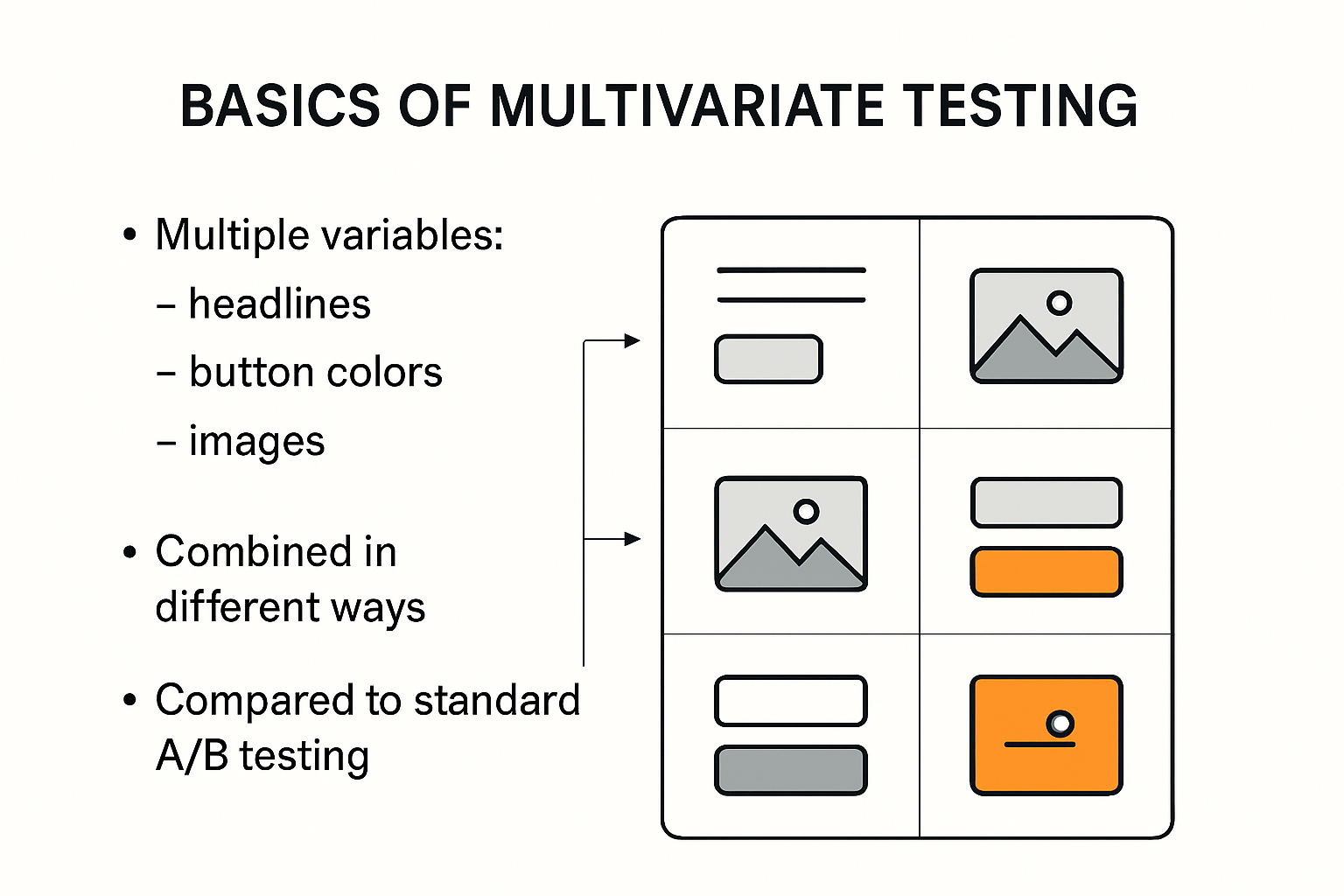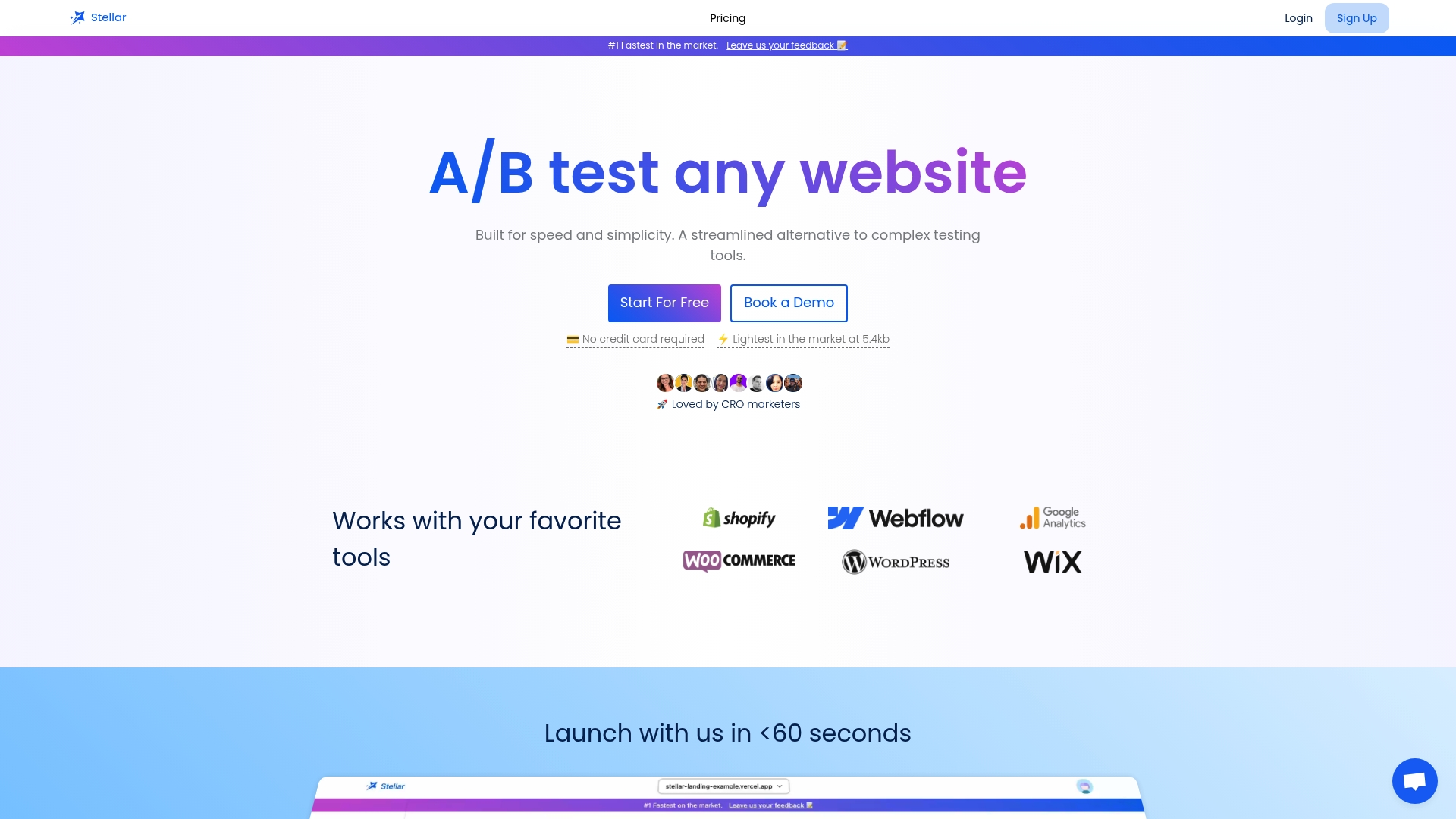
What Is Multivariate Testing? Essential Guide for Marketers 2025

Everyone wants more conversions from their website, and multivariate testing promises a smarter way to achieve it. Most marketers still rely on simple A/B tests, but that approach barely scratches the surface. The real breakthrough? Multivariate testing can uncover combinations you never expected, with brands like JoAnn.com reporting a 137 percent increase in average order value by using this advanced method.
Table of Contents
- Understanding The Basics Of Multivariate Testing
- Key Benefits For Conversion Rate Optimization
- How To Run Effective Multivariate Tests
- Real-World Examples And Best Practices
Quick Summary
| Takeaway | Explanation |
|---|---|
| Multivariate testing examines multiple variables simultaneously | This advanced experimental method helps marketers identify how different elements interact and influence user behavior, enabling better optimization of conversion rates. |
| A structured approach is essential for effective testing | Successful multivariate testing requires hypothesis development, robust test design, traffic allocation, and rigorous statistical analysis to generate meaningful insights. |
| Insights gained from multivariate testing drive data-driven decisions | By understanding complex user interactions and optimizing combinations of design elements, businesses can enhance user experiences and improve conversion rates effectively. |
| Patience and sufficient traffic are vital for successful outcomes | Multivariate testing necessitates significant website traffic to yield statistically meaningful results, making it less suitable for small platforms with limited user engagement. |
| Continuous optimization is key | Treating multivariate testing as an ongoing process allows for the consistent refinement of digital strategies, leading to more effective marketing practices. |
Understanding the Basics of Multivariate Testing
Multivariate testing represents a sophisticated optimization strategy that empowers marketers to understand complex interactions between multiple website or digital marketing elements simultaneously. Unlike traditional testing methods, this approach allows businesses to explore how different combinations of variables impact user behavior and performance metrics.
What Exactly Is Multivariate Testing?
At its core, multivariate testing is an advanced experimental method that examines multiple variables concurrently to determine which combination produces the most optimal results. According to GeeksforGeeks, this technique enables businesses to analyze how different elements interact with each other, providing comprehensive insights into user experience and conversion potential.
Unlike simple A/B testing that compares two versions of a single element, multivariate testing explores numerous potential combinations. For instance, on a landing page, you might simultaneously test variations in headline text, button color, image placement, and call-to-action wording. The goal is to understand not just which individual element performs best, but how these elements work together to influence user engagement and conversion rates.


Key Components and Methodology
Data Science Dojo highlights that effective multivariate testing requires a structured approach. The process typically involves several critical steps:
- Hypothesis Development: Identifying specific variables to test and predicting potential interactions
- Test Design: Creating a comprehensive matrix of different variable combinations
- Traffic Allocation: Distributing website traffic across different test variations
- Statistical Analysis: Evaluating performance metrics and determining statistically significant results
The complexity of multivariate testing demands robust statistical methods. Researchers use techniques like factorial design to systematically explore multiple variables simultaneously. This approach allows marketers to understand nuanced interactions that might not be apparent through simpler testing methods.
Practical Applications and Benefits
PostHog's research reveals that multivariate testing is particularly powerful for organizations seeking granular insights into user behavior. By testing several elements concurrently, businesses can:
- Optimize conversion rates more comprehensively
- Understand complex user interaction patterns
- Make data-driven design and marketing decisions
- Reduce guesswork in digital optimization strategies
While multivariate testing offers tremendous potential, it requires significant traffic to generate statistically meaningful results. Small websites or platforms with limited user engagement might find the method less practical compared to straightforward A/B testing approaches.
Successful multivariate testing demands patience, statistical rigor, and a systematic approach to experimental design. Marketing teams must carefully plan their tests, ensure adequate sample sizes, and maintain a clear understanding of their primary performance metrics.
By embracing multivariate testing, organizations can move beyond intuition-based decision-making and leverage data-driven insights to create more effective digital experiences that resonate with their target audience.
Key Benefits for Conversion Rate Optimization
Conversion rate optimization represents a critical strategic approach for digital businesses seeking to maximize their online performance. Multivariate testing emerges as a powerful technique that goes beyond traditional optimization methods, offering marketers unprecedented insights into user behavior and website effectiveness.
Comprehensive Performance Analysis
Nielsen Norman Group emphasizes that multivariate testing provides a sophisticated mechanism for simultaneously evaluating multiple website elements. Unlike simplistic testing approaches, this method allows marketers to understand complex interactions between different page components, revealing nuanced insights that can dramatically improve conversion strategies.
The comprehensive nature of multivariate testing enables organizations to move beyond isolated element assessment. By examining how different variables interact, businesses can uncover subtle optimization opportunities that might remain hidden in traditional testing frameworks. This holistic approach means testing multiple design elements concurrently rather than sequentially, saving time and resources while generating more robust analytical results.
Data-Driven Optimization Strategies
Healthcare Informatics Research highlights that multivariate testing delivers quantifiable improvements by evaluating the collective impact of various factors. Marketing teams can systematically explore how different combinations of elements influence user engagement, leading to more precise and informed decision-making.
Key optimization benefits include:
- Precise User Insights: Understand complex user interaction patterns
- Efficiency: Test multiple variables simultaneously
- Statistical Reliability: Generate statistically significant results
- Resource Optimization: Reduce time spent on sequential testing processes
Advanced Performance Measurement
The Association for Computing Machinery confirms that multivariate testing provides higher resolution data on user preferences, enabling organizations to make evidence-based decisions that directly impact conversion rates. This approach transforms website optimization from a guessing game into a precise, data-driven scientific process.
By implementing multivariate testing, businesses can:
- Identify optimal combinations of design elements
- Reduce conversion barriers
- Create more intuitive user experiences
- Maximize return on digital marketing investments
While multivariate testing offers tremendous potential, it requires sophisticated statistical analysis and significant website traffic to generate meaningful results. Organizations must approach this method with careful planning, clear hypotheses, and robust analytical capabilities.
Ultimately, multivariate testing represents more than a technical optimization technique. It is a strategic approach that empowers businesses to deeply understand user behavior, continuously improve digital experiences, and drive meaningful conversion growth through systematic, data-informed experimentation.
How to Run Effective Multivariate Tests
Running effective multivariate tests requires a strategic approach that combines careful planning, robust methodology, and sophisticated analytical techniques. Successfully implementing these tests can transform digital marketing efforts from guesswork to precision-driven optimization.
Designing Your Multivariate Test Strategy
According to Marketing Profs, effective multivariate testing begins with a clear, well-defined strategy. This involves identifying specific variables to test and establishing precise performance metrics that will guide your analysis.
Key steps in test design include:
- Goal Definition: Clearly articulate the specific insights you want to gain
- Variable Selection: Identify meaningful elements that could impact user behavior
- Hypothesis Formulation: Develop specific, testable predictions about variable interactions
- Sample Size Calculation: Ensure sufficient traffic to generate statistically significant results
The complexity of multivariate testing demands a methodical approach. Marketing teams must carefully select variables that have meaningful potential to impact conversion rates. This might include elements like headline text, button colors, image placement, or call-to-action wording.
Experimental Design and Implementation
Wikipedia's research on multivariate testing highlights several critical experimental design approaches. Full factorial designs allow for comprehensive testing of all possible variable combinations, while more advanced methods like discrete choice modeling provide nuanced insights into user preferences.
Implementation best practices include:
- Use statistical tools to create a systematic testing matrix
- Allocate website traffic evenly across test variations
- Monitor test performance in real-time
- Ensure sufficient sample size for statistical significance
Advanced Analysis and Interpretation
Marketing Analytics research emphasizes the importance of sophisticated analysis techniques. Successful multivariate testing goes beyond simple performance comparisons, requiring advanced statistical methods to uncover complex interactions between variables.
Critical analysis considerations:
- Utilize advanced statistical techniques like regression analysis
- Look for statistically significant interactions between variables
- Consider both individual variable performance and combined effects
- Validate results through multiple testing cycles
While multivariate testing offers powerful insights, it requires significant expertise. Marketing teams must balance technical complexity with practical implementation, ensuring that tests are both scientifically rigorous and actionable.
The most successful multivariate testing strategies combine technical precision with strategic thinking. By approaching testing as a continuous optimization process, businesses can unlock deeper understanding of user behavior, consistently improve digital experiences, and drive meaningful performance improvements.
Remember that multivariate testing is not a one-time event but an ongoing process of discovery and refinement. Each test provides valuable insights that can inform future optimization efforts, creating a cycle of continuous improvement in digital marketing strategies.
Real-World Examples and Best Practices
Multivariate testing has transformed digital strategy across numerous industries, offering powerful insights that drive meaningful business improvements. By examining real-world applications, organizations can understand the practical potential of this sophisticated optimization technique.
E-commerce Optimization Success Stories
Marketing Experiments revealed an extraordinary case study from JoAnn.com, an arts and crafts retailer. Through strategic multivariate testing, they achieved remarkable results:
- 137% increase in average order value
- 209% boost in revenue per visitor
- Discovered counterintuitive offer combinations that significantly outperformed initial expectations
This example demonstrates how multivariate testing can challenge existing assumptions and uncover unexpected optimization opportunities. By systematically testing multiple variables simultaneously, businesses can identify high-impact strategies that might otherwise remain hidden.
Here is a table summarizing some of the impressive statistical results and key outcomes achieved through multivariate testing in notable case studies:
| Company/Platform | Test Highlights | Key Results |
|---|---|---|
| JoAnn.com | Multiple offer combinations | 137% increase in AOV; 209% boost in RPV |
| YouTube | 1,000+ design combinations tested | Systematic UX/data-driven improvements |
| Continuous UI multivariate testing | Increased user engagement and satisfaction |
Large-Scale Technology Platform Implementations
Smashing Magazine highlights YouTube's groundbreaking approach to multivariate testing. In 2009, the platform conducted an extensive experiment involving over 1,000 design combinations, showcasing the scalability and depth of multivariate testing methodologies.
Key insights from large-scale testing implementations include:
- Ability to test complex, multi-dimensional design scenarios
- Systematic approach to user experience optimization
- Data-driven decision-making at unprecedented scales
Social Media and User Experience Refinement
Digital Authority documented Facebook's continuous use of multivariate testing to enhance platform design. By meticulously examining various interface configurations, Facebook demonstrates how ongoing experimentation can drive user engagement and satisfaction.
Below is a checklist table highlighting best practices for running effective multivariate tests, as described in the article:
| Best Practice | Description | Critical? |
|---|---|---|
| Comprehensive Variable Selection | Choose meaningful elements for testing | Yes |
| Statistical Rigor | Ensure sufficient sample size & significance | Yes |
| Continuous Iteration | Ongoing optimization, not just one-time | Yes |
| Cross-Functional Collaboration | Include design, marketing, and analytics teams | Yes |
Successful multivariate testing requires more than technical expertise. It demands a cultural commitment to data-driven innovation, where hypotheses are systematically validated and insights continuously integrated into strategic planning.
Organizations that embrace multivariate testing move beyond intuitive guesswork, transforming digital optimization into a precise, scientific discipline. By learning from industry leaders and implementing robust testing frameworks, businesses can unlock unprecedented opportunities for growth and user experience enhancement.
Frequently Asked Questions
What is multivariate testing?
Multivariate testing is an advanced experimental method that evaluates multiple variables simultaneously to identify which combination optimally influences user behavior and conversion rates.
How does multivariate testing differ from A/B testing?
Unlike A/B testing, which compares two versions of a single element, multivariate testing examines multiple elements and their interactions at once, providing deeper insights into user engagement.
What are the key benefits of multivariate testing for marketers?
Multivariate testing offers comprehensive performance analysis, data-driven optimization strategies, and advanced performance measurement, enabling marketers to understand complex user interactions and improve conversion rates.
How can I run effective multivariate tests?
To run effective multivariate tests, start with a clear strategy, define your variables and metrics, ensure sufficient sample sizes, and utilize robust statistical analysis to interpret results.
Stop Guessing and Start Seeing Real Growth From Your Experiments
After reading about the complexity and high-traffic demands of multivariate testing, you may feel your team lacks the right resources or tools to uncover hidden performance insights. Maybe your current A/B testing methods are holding you back. Imagine running advanced tests and seeing results quickly—all without writing code or slowing your website down.

Stellar makes testing easier and smarter. With its no-code visual editor, you can refine headlines, buttons, and calls-to-action effortlessly, just as discussed in the article. Enjoy lightweight performance with the smallest script in the industry, while accessing real-time analytics and advanced goal tracking. Take action now so your business can unlock data-driven results and win more conversions. Ready for efficient experimentation? Get started for free at gostellar.app today.
Recommended
Published: 7/21/2025
